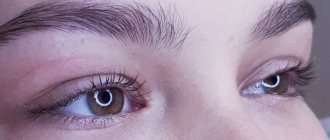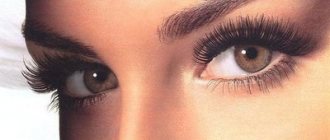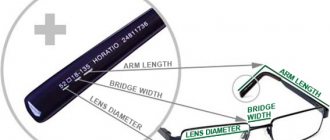Distance glasses are an effective means of vision correction prescribed for myopic patients. The main indication for wearing such products is varying degrees of myopia. For persons with the initial stage of pathology, such devices are prescribed less frequently. Basically, the need to use distance glasses arises with myopia levels of -2 D.
This type of optics has the following characteristics:
- improves vision at long distances;
- helps to clearly perceive distant objects;
- created using negative lenses that scatter light rays.
Such products can be prescribed to patients of different ages. Thanks to the use of distance glasses, it is possible to get rid of the inconveniences that arise while studying, driving, watching TV, visiting the cinema, theater, etc.
If the degree of myopia exceeds -6 diopters, a person has difficulty distinguishing not only distant objects, but also other objects. In this case, he will need two pairs of glasses - for distant and near vision. In this case, the second version of optics should be on average 2 times weaker than products for distance.
What is the difference from reading glasses?
Both types of glasses (for distance and for reading) are designed to solve similar problems - normalizing the work of the eye muscles, viewing objects from a certain distance. Such products improve the quality of visual perception, stimulate the visual apparatus, and reduce the load on it.
At the same time, there are important differences between such designs. The first version of optics is equipped with lenses curved inward and is aimed at correcting myopia. When making reading glasses, glasses (plastic) are used that are curved outward, have a plus value, and collect light rays. Thanks to this device, it is possible to better see the text, as well as objects located nearby.
As already mentioned, distance optical products are addressed to myopic persons. The use of reading glasses is mainly needed by people whose visual acuity decreases due to natural aging of the body. This category traditionally includes patients over 40-45 years of age who suffer from age-related farsightedness (presbyopia).
People who are simultaneously diagnosed with nearsightedness and farsightedness require “2 in 1” glasses, called bifocals. Such devices become relevant when the patient requires vision correction both far and near.
In order to simultaneously improve far and near vision, modern ophthalmologists are increasingly prescribing options with progressive lenses, which differ from bifocal products in greater ease of use.
Magazine
Photo source: pexels.com
We all know that contact lenses have a limited lifespan, which is not recommended to be exceeded. We explain why this is dangerous for eye health in our blog.
Glasses, unlike contact lenses, do not have a specific expiration date: it can be three years, five years, or more. It all depends on the quality of the frames and lenses, the degree of wear and tear and how you wear them.
Let's start with spectacle lenses. As you know, ophthalmologists recommend checking your vision at least once a year. If during this time your vision changes, then the lenses will require replacement. However, high-quality lenses, as a rule, stabilize vision and stop the progression of myopia, and therefore they will last much longer than one year. This is why the specialists at Point of View Optics advise not to skimp on lenses - be prepared for the fact that the more needs you have, the more expensive the glasses will be. The question of what affects the cost of spectacle lenses is answered here.
The service life of the frame also directly depends on its quality, on what material it is made of. If you suddenly wondered why one frame costs several times more than another, then the answer can be found here.
Remember that there is one simple principle regarding the lifespan of glasses: the more carefully you handle your glasses, the longer you will wear them.
- Don't neglect the rules of eyeglass care. Store them in a hard case, clean them regularly and do this using special sprays and soft microfiber cloths. This will protect your lenses from scratches.
- If you bought glasses at Point of View optical stores, do not forget to regularly send them for maintenance (cleaning, straightening and repair) as part of free service. All conditions and possibilities are described in our material.
- Use glasses strictly for their intended purpose and not as a hairband.
Point of View experts advise changing your glasses when scratches appear on the lenses, making it difficult to see, and the frames no longer hold up as well as before, even after they have been straightened and repaired. And, of course, when you simply want a change and please yourself with new stylish glasses. You will always find a large selection of frames and high-quality spectacle lenses in Point of View optical stores, and specialists will help you choose what is right for you.
Selecting distance glasses
You should choose distance glasses together with your doctor. Before receiving an order for the manufacture of an optical structure, you will need to undergo a detailed ophthalmological examination, during which the following will be clarified:
- visual acuity;
- degree of myopia;
- presence of astigmatism;
- the presence of other pathologies of the visual system.
During the diagnostic process, the distance between the pupils will be measured, which is important when selecting corrective glasses.
Having an ophthalmologist's prescription in hand, you should visit a center that produces custom optics. Next, you need to choose the right frame:
- It is recommended to focus on models that have a comfortable fit on the bridge of the nose. The best option would be products with adjustable nose pads made of non-rigid material. Thanks to the presence of such a part, there will be no redness, chafing, or excessive pressure.
- You need to make sure that the temples fully correspond to the parameters of your face. They should not put pressure on the temple area or cause the product to fit unreliably.
- It is worth choosing models consisting of lightweight material. At the same time, it must match the thickness of the lenses and easily withstand glass or plastic inserted into the frame. It is important to consider that metal versions can cause allergies in people with hypersensitivity.
Unlike children, adults have a fully formed visual apparatus. This allows you to moderately experiment with frames and choose models that give your appearance more expressiveness. Only anatomically ideal products are shown to persons under 18 years of age.
When choosing lenses, you should pay special attention to plastic options that are resistant to falls. Unlike glass, when struck, plastic does not break into small particles that can enter the eye and damage it. A good choice would be a hardened material that is highly resistant to scratches.
Many adult patients prefer distance glasses with photochromic lenses. Such products can change color depending on the intensity of light indoors or outdoors. Such optics are considered especially useful for the eyes, because helps protect them from the negative effects of various types of radiation (ultraviolet, computer).
How to choose corrective glasses with different diopters?
Any deviations in vision from the norm cause great discomfort, all “bespectacled people” who do not part with contact correction devices know this. Some defects can be corrected simply when the readings of the right and left eyes are the same. But if there is a difference in diopters, choosing glasses or lenses is a little more difficult.
Ophthalmologists note that if the difference in vision between the left and right eyes exceeds three diopters, choosing glasses for constant wear will be problematic. Many patients experience discomfort and malaise. Thus, users of glasses with different diopters often complain of headaches, eye strain and associated general weakness. And in this case, contact lenses will be the best option. In cases where the optical power of the right and left eyes does not differ much, doctors usually prescribe glasses with glasses with the same diopters, focusing on the lower value. With this selection option, the patient sees much better, and wearing corrective devices becomes more comfortable.
In any case, you should never choose glasses yourself. Only a competent optometrist, after a series of tests and hardware diagnostics, will be able to assess the quality of vision and write a prescription for glasses that will correct vision and be comfortable. Don’t be surprised if you see diopters in your prescription that differ from the actual optical power of your eyes: doctors always recommend wearing glasses with an optical power that is one or one and a half steps less. This is done in order to prevent the progression of the disease, be it myopia or farsightedness. If it comes to selecting glasses for astigmatism or correcting age-related farsightedness, then it is even more necessary to approach the issue very carefully and determine a number of additional parameters.
The question often arises as to why it is not possible to buy ready-made prescription glasses if the required dioptres are known. This is impossible to do, since it is also necessary to know the interpupillary distance. Experienced users also make one common mistake: they buy new glasses to replace old ones, using a prescription issued some time ago. This is also incorrect, since vision indicators change over the years, it can worsen and even improve if the patient is relatively young, follows the regime of wearing contact correction devices, and does eye exercises. Therefore, before purchasing a new pair, you should always double-check.
How to wear
When using distance optical devices, the following recommendations must be observed:
- If the refractive error does not exceed -1 diopter, the product should be used periodically, if necessary, when viewing objects that are particularly far away.
- It is necessary to wear glasses to perceive visual information or what is written on the board (during classes, lectures).
- You should not abuse wearing optics if you do not have an urgent need to distinguish distant objects (when going to the store, while walking on the street, relaxing in nature).
- It is not advisable to wear someone else's glasses or let them use your own. Such actions can provoke a deterioration in visual function.
- You should avoid reading the fine print found on posters, advertising banners, etc.
Wearing distance glasses, you should not spend a long time in front of a TV screen or computer monitor. When playing sports or other types of physical activity, they must be removed. In order not to cause overwork of the visual organ, ophthalmic exercises should be performed in between wearing optics.
To extend the life of an optical product, it must be removed and put on correctly. To do this, you should hold onto the structure with both hands, at the junction of the temples with the frame. You cannot remove glasses by one arm - such actions lead to their rapid loosening and frequent breakdowns.
Pros and cons of progressive lenses
Manufacturers note a number of advantages that progressive optics have. These include:
- the ability to use one glasses for good vision at different distances, to perform several types of work;
- the absence of a sharp “jump” in the image due to a special corridor, as happens with conventional bifocal and trifocal optics, when a person moves his gaze from one object to another;
- There is no sector division visible on the glass - they look solid;
- To produce glasses, they use not only glass, but also plastic, including polycarbonate, which makes it possible to produce products in different price categories and make them accessible to people with low incomes.
Pros and cons of progressive lenses
Unfortunately, the device is not ideal and has a number of disadvantages . These include:
- the presence of “blind” zones in which the image is distorted;
- narrow peripheral zone;
- longer adaptation period than when using conventional bifocal optics;
- not all people adapt to such glasses;
- quite high cost.
It is worth noting that over time, most people get used to the features of glass. In addition, manufacturers are trying to improve the invention.
Lenses are not suitable for everyone
Another disadvantage of lenses is contraindications. The table indicates diseases for which such glasses are not recommended or prohibited.
| Name of the disease | Problem | Cause |
| Strabismus | The parallelism of the visual axes is disturbed | The eyes can see different areas of the lens at the same time |
| Anisometropia | The eyes have different diopters (the difference is 2 diopters or more) | |
| Cataract | Cloudiness of the eye lens has developed, which affects the quality of visual function | It is impossible to achieve stable vision correction |
| Nystagmus | Frequent involuntary fluctuations of the pupil | There is no stability of the pupil in the progression corridor, it falls into distortion zones |
There are works in which the gaze falls into the zone of natural distortions of optical glass. For example, when playing the violin, the musician looks towards the lower left corner, where the distortion zone is. Such people should use regular lenses.
Lens overview
You should also pay special attention to the choice of glasses:
- workers in the medical field and related fields - dentist, surgeon, cosmetologist, hairdresser, manicurist;
- transport drivers and operators of special equipment - aircraft pilot, crane operator;
- those whose work requires special precision - jewelers, car mechanics, etc.
Progressive optics are not designed for long-term work with small objects; it is uncomfortable to read or watch TV while lying on your side.
Video: How to avoid mistakes when choosing progressive lenses
Rules for using progressive glasses
Although the device is very convenient, you need to adapt to it. It will take a few days to get used to. Thanks to the rules outlined below, this will be easy.
- Having bought new glasses with progressive lenses, you need to forget about the old ones and not use them.
- To use peripheral vision at medium and far distances, the head is slightly turned in the desired direction.
- It will take practice to fix your gaze well. They perform the following exercise: they look from a nearby object (for example, a book in their hands), to a distant object (a tree outside the window) and to one located at a medium distance (a painting on the wall).
- To read books and newspapers, you need to find the optimal position by changing the direction of your gaze. The reason is that the working distance turns out to be slightly larger than 40 cm. After some time, the eyes will learn to focus automatically.
- When walking up stairs, use the intermediate zone of the lens, for which you tilt your head down slightly.
- They get behind the wheel of a car only after mastering the skills mentioned above. Driving begins on roads with little traffic, where less concentration is required, since at first the brain is busy getting used to the new gadget.
Rules for using progressive glasses
They train for half an hour every day until all movements are perfected and brought to automaticity. Only after complete adaptation do you feel all the benefits of using progressive lenses.
As mentioned above, not everyone is able to get used to these lenses; the proportion of such people reaches 10–15%. For this case, a number of manufacturers have developed special exchange programs. If the glasses do not fit, the client has the right to change the lenses to single vision ones. But from the very beginning, when buying a product, you should take into account: if the glasses do not fit, it is unlikely that you will be able to return the full price.
Often a simple adjustment of the frame helps with adaptation. Here are situations in which you should contact a specialist for help:
- there are lateral distortions;
- the reading area is too small, there are distortions when moving the gaze along the progression channel;
- to look at a long distance, you need to tilt your head forward, and while reading, raise your glasses;
- the image in one of the zones or in two at once is not clear enough.
Video: How to properly try on progressive lenses
How is the price determined?
There are three factors that will determine the price of glasses.
- Manufacturer . Traditional scheme: the more famous the brand, the higher the cost, and, as a rule, the better the quality of the product and the credibility of it.
- Channel width . As the channel expands, the price also increases.
- Thinning index . Thin lenses are more expensive, but they are not always better. In this criterion, it is necessary to follow the instructions of the doctor, who knows better about the needs of the patient.
How the price of progressive lenses is determined
Video: The whole truth about progressive (multifocal) glasses
Lenses with additional features
The market for optical products is quite large, and many companies are engaged in the production of glasses with progressive lenses. This allows you to choose a product with the widest range of useful characteristics.
BBGR brand produces lenses for right-handers and left-handers. This innovation is based on scientific research, the results of which have shown that a person’s visual response depends on body position.
Seiko brand has a Drive for those who drive a car. The lenses provide clear vision at medium and long distances, and also guarantee good visibility and, accordingly, greater safety when driving a vehicle.
Study the circles before your eyes using the link.











